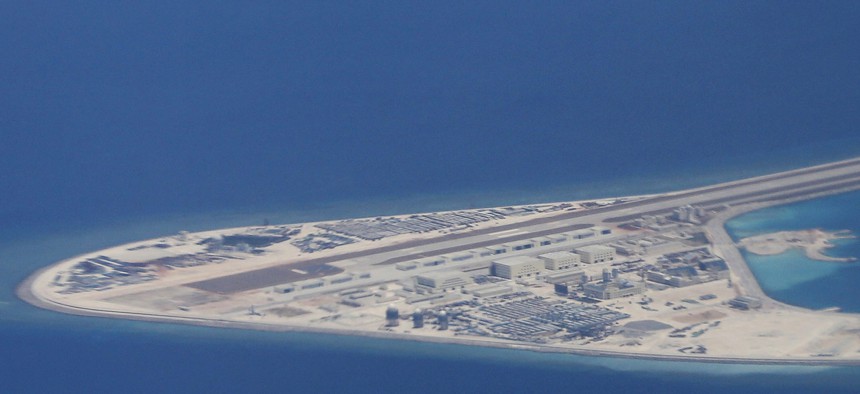
An airstrip, structures and buildings on China's manmade Subi Reef in the Spratly chain of islands in the South China Sea in April 2017. AP Photo/Bullit Marquez
Pentagon: Beijing Is Arming Its Manmade Islands in South China Sea
With its reef expansion apparently finishing up, China is working to extend the reach of its military power.
China is outfitting its manmade island outposts in the South China Sea with warplane hangars and weapons, the Pentagon said Tuesday in its annual assessment of Beijing’s military.
Once finished, the People’s Liberation Army Air Force intends to base three regiments of warplanes there, says the report, which was “generated” on May 15 and released to the public today.
“Although its land reclamation and artificial islands do not strengthen China’s territorial claims as a legal matter or create any new territorial sea entitlements, China will be able to use its reclaimed features as persistent civil-military bases to enhance its presence in the South China Sea and improve China’s ability to control the features and nearby maritime space,” the report says.
Last year’s edition of the China-power report noted Beijing had completed its reclamation work on the islands. Think tanks and news organizations have previously reported the missile deployments and hangar construction, however this is the first time they have appeared in the Pentagon's annual China report.
“China’s actions in the South China Sea in 2016, particularly its construction of airfields and other infrastructure on features in the Spratly Islands, enhanced China’s ability to control disputed areas in the South China Sea and caused regional concern over China’s longterm intentions,” the report states.
China has stopped expanding the reefs and is now working to add military infrastructure to them, the report states. New installations include airfields with runways of at least 8,800 feet, water and fuel storage, large port facilities, 24 fighter-sized hangars, communications facilities, fixed-weapons positions, barracks and administration buildings.
In March, the Center for Strategic and International Studies — a Washington think tank that has tracked the island expansion — said China was finishing up construction of the islands.
“China’s three air bases in the Spratlys and another on Woody Island in the Paracels will allow Chinese military aircraft to operate over nearly the entire South China Sea,” it said. “The same is true of China’s radar coverage, made possible by advanced surveillance/early-warning radar facilities at Fiery Cross, Subi, and Cuarteron Reefs, as well as Woody Island, and smaller facilities elsewhere.”
Meanwhile, China could soon have new, advanced warplanes to base on those faux islands. Two new stealth fighters — the J-20 and FC-31 — could be battle-ready as soon as next year, the Pentagon states.
Last July, The Hague international tribunal rejected China’s claims in the South China Sea, including a claim to historical ownership of the region. In turn, the Chinese government rejected the ruling, with state media claiming that, “The Chinese government and the Chinese people firmly oppose it and will neither acknowledge it nor accept it.”
The U.S. has refused to recognize the claims and has sent military ships and aircraft near the islands in what it calls freedom-of-navigation operations — most recently last month.
William Morris IV contributed to this report.
